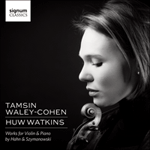‘Ibragimova and Tiberghien make a winning combination, both in the sweltering sensuality of the central works and in the more conventional late-Romantic effulgence of the warm-hearted Sonata of 1909 … this repertoire should be high on the priority list of all those interested in 20th-century violin music, and it's not easy to imagine a stronger case being made for it than here’ (Gramophone)
‘[I would] recommend Alina Ibragimova with pianist Cédric Tiberghien as prime representatives of the numinous in Szymanowski's violin chamber repertoire’ (Gramophone)
‘This is a performance that shows Ibragimova's art at her remarkable best; at one moment poised, the next playing with abandon, she is one of the most expressive violinists around’ (BBC Music Magazine)
‘Ibragimova and Tiberghien produce beautifully characterised accounts, whether in the veiled contours of the Nocturne and the explosion of rhythmic energy that follows it in the Tarantella, or in the refined exoticism of Mythes, with its strange mixture of classical evocation and sensuous indulgence’ (The Guardian)
‘We are living in a Second Golden Age of violinists, but even in the context of Hilary Hahn, Leila Josefowitz and Julia Fischer, Alina Ibragimova is an astonishing talent … technically the playing is superb. Intonation is exceptional, and Ibragimova's timbral range—from the coarse to the silken, from the richly throbbing to the chastely disembodied—seems unlimited. The music is studded with challenges … she tosses it all off with self-confident authority … Cédric Tiberghien, with whom Ibragimova has played often, offers a real partnership rather than mere support … this is a major release’ (International Record Review)
‘Ibragimova's stunningly potent technique—the stuff of legend even in the close scrutiny of the digital age—is soon forgotten in a sensuous croon through which the more extravagantly impossible the violinistic hurdles, the more ecstatically glorious her tone becomes. Indeed, hurdles do not exist for her, and the usual descriptive and critical terms are useless, if only because they suggest comparison with other artists suddenly dwarfed by the incomparable. Such phrases as 'a tonal palette ranging from guttural coruscation to the most brilliantly glowing scintillance' simply will not do. There is a touch of the uncanny here, even a suggestion of the human voice—as of whispers, sighs, moans, wailing—in which the notes dissolve into a direct spiritual prehension. Ibragimova does not play or perform—she utterly possesses’ (Fanfare, USA)
‘The early violin sonata is especially fine, as are the little-known Paganini caprices’ (The Evening Standard)
‘The beautiful 24-year-old Russian violinist Alina Ibragimova teams with French pianist Cedric Tiberghien to prove that Szymanowski's violin music is the most impressive of his chamber music, especially the Scriabinesque Violin Sonata in D-minor Op 9. An exceptional disc’ (The Buffalo News, USA)


 Szymanowski & Hahn: Violin Sonatas
Szymanowski & Hahn: Violin Sonatas
